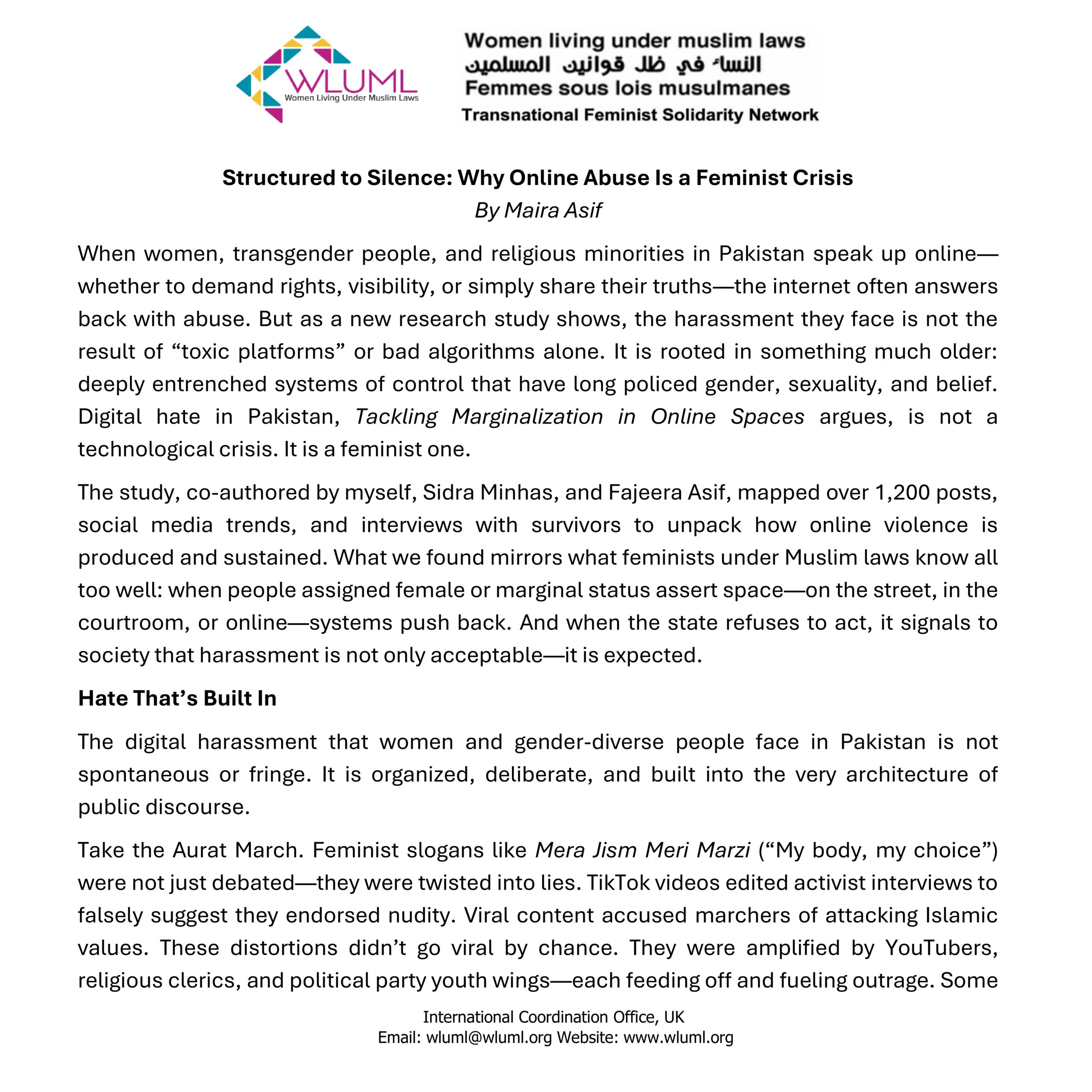Structured to Silence: Why Online Abuse Is a Feminist Crisis
By Maira Asif
When women, transgender people, and religious minorities in Pakistan speak up online—whether to demand rights, visibility, or simply share their truths—the internet often answers back with abuse. But as a new research study shows, the harassment they face is not the result of “toxic platforms” or bad algorithms alone. It is rooted in something much older: deeply entrenched systems of control that have long policed gender, sexuality, and belief. Digital hate in Pakistan, Tackling Marginalization in Online Spaces argues, is not a technological crisis. It is a feminist one.
The study, co-authored by myself, Sidra Minhas, and Fajeera Asif, mapped over 1,200 posts, social media trends, and interviews with survivors to unpack how online violence is produced and sustained. What we found mirrors what feminists under Muslim laws know all too well: when people assigned female or marginal status assert space—on the street, in the courtroom, or online—systems push back. And when the state refuses to act, it signals to society that harassment is not only acceptable—it is expected.
Hate That’s Built In
The digital harassment that women and gender-diverse people face in Pakistan is not spontaneous or fringe. It is organized, deliberate, and built into the very architecture of public discourse.
Take the Aurat March. Feminist slogans like Mera Jism Meri Marzi (“My body, my choice”) were not just debated—they were twisted into lies. TikTok videos edited activist interviews to falsely suggest they endorsed nudity. Viral content accused marchers of attacking Islamic values. These distortions didn’t go viral by chance. They were amplified by YouTubers, religious clerics, and political party youth wings—each feeding off and fueling outrage. Some were ideologically invested. Many were simply opportunistic. As the study shows, digital hate now has an economic model: controversy sells, and feminists are prime targets.
This opportunism is critical. Many of the actors profiting from hate—social media influencers, lifestyle vloggers, and sensationalist media pages—have no political theology or religious training. But they operate in a system that rewards the policing of women, trans people, and minorities, and punishes visibility. Hate becomes content. Content becomes currency.
Trans Lives as “Threats to Order”
No group illustrates the convergence of religious panic and digital hate more than transgender and non-binary communities. The Transgender Persons (Protection of Rights) Act of 2018 became the subject of coordinated disinformation, with hashtags like #AmendTransgenderAct framing it as an attack on Islamic morality. Senator Mushtaq Ahmed’s speeches warned of a “Western agenda to destroy the family,” echoed by influencers like Maria B, who posted Instagram stories urging followers to oppose the law. What followed was a digital mob—comments calling for arrests, beatings, and “re-education.”
The study shows these campaigns are not just harmful—they are strategic. Transphobia is packaged as moral concern, letting hate masquerade as righteousness. And when social media companies don’t moderate this content in Urdu or regional languages, the abuse continues unchecked.
Religious Minorities: From Hashtags to Violence
Digital hate is also used to incite violence against religious minorities—especially Ahmadis, Christians, Hindus, and Sikhs. Hashtags like #AhmadisAreNotMuslims and #JaranwalaIncident were heavily used during and after real-world attacks on Christian communities. In one case, a fake Facebook profile using a Hindu activist’s name posted blasphemous content to trigger mob retaliation. It worked.
This isn’t just cyberbullying. It’s a calculated use of digital tools to enforce who gets to be safe, visible, or vocal in Pakistan—and who does not. The silence of the state, combined with the complicity of platforms, makes this system not broken, but perfectly functional for oppression.
A Familiar Pattern, A Shared Struggle
These digital dynamics—where visibility invites attack, where religious morality justifies abuse, and where laws meant to protect are used to silence—are not unique to Pakistan. Across Muslim-majority contexts, women who challenge dominant norms face the same backlash. Whether it’s feminist lawyers in Egypt being imprisoned, trans activists in Indonesia being doxxed, or secular bloggers in the diaspora being harassed into silence—the script repeats.
That’s why this cannot be treated as a “tech” issue. Content moderation alone won’t save us. Because the abuse isn’t generated by a glitch in the system. It is the system—just now playing out on a new stage.
What Feminist Resistance Requires
Our research calls for something far more comprehensive: survivor-centered, identity-specific, and justice-oriented reform. That includes:
- Multilingual digital safety tools for those targeted by hate.
- Civil remedies like digital restraining orders and compensation.
- Accountability for political parties, clerics, and influencers who incite digital violence.
- Independent oversight of cybercrime agencies to prevent abuse of power.
- And most importantly, a feminist reimagining of digital rights that centers the most vulnerable, not just the loudest or most powerful.
At Women Living Under Muslim Laws, we know that systems of control mutate across borders. The digital space may be new, but the logic is not. What Pakistan shows us is how religious nationalism, patriarchy, and capitalism converge online to punish those who dare to exist outside the margins.
To resist this, we need more than digital literacy. We need feminist firewalls—transnational, unapologetic, and built in solidarity.
Because online or offline, our resistance is not just reactive. It is revolutionary.


